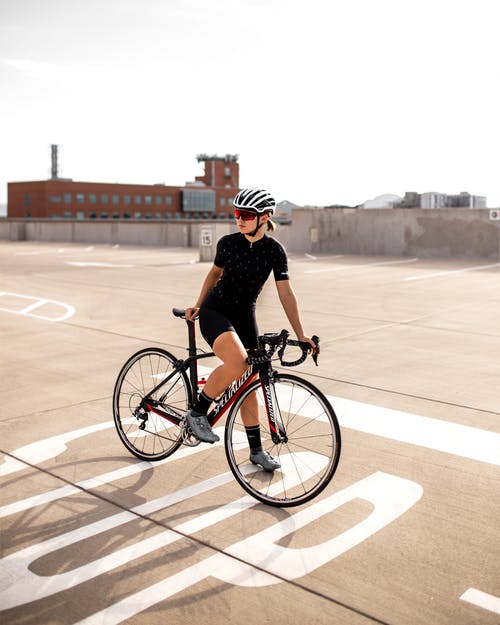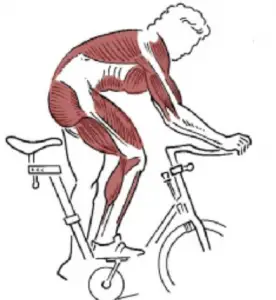Table of Contents
What Muscles Work When Cycling
For many avid cyclists, building leg muscles is a key ingredient, especially when competing. The logic is that more developed leg muscles allow you to pedal faster and harder, increasing speed and making it easier to navigate difficult sections of the track.
Cycling itself increasesmuscle endurance. But if you do not have the time and opportunity to do it, sign up for the gym – special sports equipment fully replaces the bike and allows you to adjust the figure.
What muscles work on a bicycle? If you think that while riding a bike you can only pump up your legs, you are wrong!
Why? Let’s take a look at this issue.
What Muscles work on a bicycle?
What muscles does a bicycle develop? The quadriceps, hamstrings, calf and gluteal tendons are the main groups that are involved when riding a bike. These large muscle groups burn more calories than smaller muscle groups such as the biceps. Let’s take a closer look at which muscles swing on a bike:
Quadriceps – located in front of the thigh, are responsible for straightening the leg and pushing the pedal to the ground.
The gluteus maximus and median -are located in the buttocks and are responsible for pushing the pedal forward at the top of the push.
Hamstrings – Located on the back of the thigh, they work with the calf muscle to lift the pedal up.
They all work together to provide pedaling power and endurance while riding. Depending on the type and speed of the ride, you will use some of these muscles more than others.
If the terrain is hilly, the quadriceps will do most of the hill-climbing work. To climb the mountain, mainly the gluteal muscles will be involved. When driving at high speed, all leg muscles are involved.
How do muscles work?
Thousands of fine spaghetti-like fibers make up muscle tissue. They receive messages from the brain by causing the fibers to contract. The main muscles when working on a bicycle are the quadriceps and hamstrings in the upper part of the lower leg, as well as the calf and plantar muscles in the lower leg.
The brain sends a signal to the body, no matter what muscles are exercised when cycling. But what feeds the fiber during the thousands of contractions that occur during a long trip?
You’ve probably heard the terms aerobic and anaerobic. They describe two ways in which muscles receive energy.
In aerobic exercise, tissues use oxygen, glucose, and fatty acids carried in the blood to produce adenosine triphosphate. ATP is a source of energy that allows muscles to contract.
The ability to ride a bike for a long time depends on the delivery of oxygen and fuel molecules (glucose and fatty acids) to the fibers. This, in turn, depends on the circulation and respiration provided by the heart and lungs.

When you do anaerobic exercise, your muscles draw on stores of glycogen (which is made from glucose) and convert them to ATP.
During this type of high-intensity exercise, the fibers generate energy without oxygen. Anaerobic training comes at a cost as a waste product called lactic acid builds up. It causes burning and fatigue.
Now let’s get back to which muscles are affected by cycling.
The process itself is incredibly beneficial to health, increasing fiber strength and general balance skills. From the core muscles, including the abdomen and back, the abdominal and oblique muscles benefit the most, and maintaining a tight abs while skating strengthens them even more.
Increasing abdominal strength relieves tension in the muscles of the lower back and may reduce lower back pain. Cycling also has a positive effect on the hip flexors. They play a key role in balance – an important skill for the cyclist.
Cycling mainly uses the muscles of the lower body. Do you know which muscles are still tense when cycling? Shoulder (deltoid) and arms (biceps, triceps). Many cyclists stand, lean forward, or crouch while climbing, trail riding that requires upper body support.
1.With circular movements of the pedals, if you imagine a clock, the muscles of the thigh or fours are used as much as possible at the 9 o’clock position, in the phase of pulling up.
The cycle begins when the hip and knee press down on the pedal. This action is assisted by the gluteal and quadriceps muscles, followed by the hamstrings and calf muscles.
2.The gluteal fibers are responsible for the beginning of the downward phase of the bicycle pedal travel, so they work every time you press.
You can improve your tone by going to the mountains. Steep hills make the muscles work harder. The ride will create a lot of tension on both the glutes and thighs. This results in improved strength and muscle tone after recovery.
3.Cycling works on the calf muscles through plantar flexion during the pedal stroke. Plantarflexion is actually the same action that is created when you are on tiptoe.
The maximum tension occurs at the points of pedal travel, which correspond to five and six o’clock on the dial – the leg bends and the toes point downward.
The calf muscles play a small role in cycling, but the benefits from them will be fully justified by their slimness and beautiful relief.
4. Riding a bike raises your heart rate, which helps burn calories and can lead to weight loss (provided you eat well);
5.During such trips, the press is activated to keep the pedal in a stable position. The abdominal musculature is part of the main muscular unit of the body that provides a stable platform for riding and allows the upper to be used for support and smooth steering;
6.The abdominal muscles contract isometrically to provide stability. These persistent micro spasms of the fibers help to tone the muscles, increase strength and endurance.
To ensure the correct effect on the muscles of the abdomen, tense this area as much as possible to pull the navel inward. Lower your body slightly, try to maintain this position throughout the ride. After a short time, this position will become natural when riding a bike.
Сycling and Carbohydrates
Cycling or just cycling is energy-intensive. The muscles of the legs are mainly involved in the work – this is a very large muscle group.
During riding and especially high-speed jerks, glycogen is quickly consumed in the muscles. Glycogen is the main fuel used by the body for movement, the more it is stored before training, the more enduring you will be.
For the cyclist, the quality of carbohydrates comes first!
Experienced athletes understand that it is necessary to stock up on glycogen in advance of the start, before training. We recommend eating foods containing slowly digestible carbohydrates and proteins. These meals include sweet potatoes, brown rice, durum pasta, and the optional slow-carb gainer
Don’t be afraid of calories! Professional athletes are trying to gain a kilogram, two before a responsible start, you will need these couple of kilos and will disappear during the race.
Additionally an easily digestible gainer with slow carbohydrates:
1.Optimum Nutrition
2.Optimum Nutrition Gold Standard
3.Vital Proteins Collagen Peptides
In conclusion ,Some Tips:
Reduce the risk of injury while standing by shifting your weight to your legs and feet.
When racing, lean forward, use your arms and shoulders only to maintain balance. Keep your body weight centered.
Different types of sports have different effects on the body, for example sprinting uses the large muscles of the legs. Traveling long distances at a steady speed increases endurance, helps build stronger legs, but does not increase muscle mass much.
If you really want to increase your fiber mass, you have to go to the gym. High weights and low reps are great ways to build leg muscle.
Support our research at Patreon and Get Unique Rewards Here =)
BurnMyFatFast.com main goal is to help you achieve your fitness goals! Be with us!


